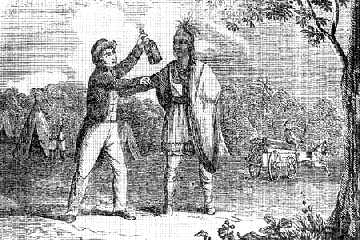Be prepared. Here comes a Debbie Downer post.
Many critics of Sherman Alexie's The Lone Ranger and Tonto Fistfight in Heaven argue that he was furthering the stereotype of 'The Drunken Indian' in his book because in nearly all the short stories alcoholism is rampant. Alexie argued that he wrote only what he saw and you can't fault the guy for his memories. Many people might not know the relationship between alcohol and the Native American population and I think it is important that we do.
It is a common misconception that Indians had never seen alcohol before the Europeans arrived. Long before the arrival of the Europeans many different tribes of Indians were fermenting alcohol from native ingredients like maize and sap from maple trees. However, these alcoholic substances were often very mild and used only ceremonially. They were nothing like the alcohol that Europeans would later bring over.
Alcohol, as we know it, was introduced, in vast amounts, to Indians by the European colonists. It was introduced mostly through trade. The Europeans would use alcohol to trade for furs, often cheating the Indians. This unfair trade balance existed for many years. In a book called We Pointed them North: Recollections of a Cowpuncher the author, "Teddy Blue" Abbot wrote,
Many critics of Sherman Alexie's The Lone Ranger and Tonto Fistfight in Heaven argue that he was furthering the stereotype of 'The Drunken Indian' in his book because in nearly all the short stories alcoholism is rampant. Alexie argued that he wrote only what he saw and you can't fault the guy for his memories. Many people might not know the relationship between alcohol and the Native American population and I think it is important that we do.
It is a common misconception that Indians had never seen alcohol before the Europeans arrived. Long before the arrival of the Europeans many different tribes of Indians were fermenting alcohol from native ingredients like maize and sap from maple trees. However, these alcoholic substances were often very mild and used only ceremonially. They were nothing like the alcohol that Europeans would later bring over.
Alcohol, as we know it, was introduced, in vast amounts, to Indians by the European colonists. It was introduced mostly through trade. The Europeans would use alcohol to trade for furs, often cheating the Indians. This unfair trade balance existed for many years. In a book called We Pointed them North: Recollections of a Cowpuncher the author, "Teddy Blue" Abbot wrote,
“You take one barrel of Missouri River water, and two gallons of alcohol. Then you add two ounces of strychnine to make them go crazy—because strychnine is the greatest stimulant in the world—and three plugs of tobacco to make them sick—an Indian wouldn’t figure it was whisky unless it made him sick—and five bars of soap to give it a bead, and half a pound of red pepper, and then you put in some sagebrush and boil it until it’s brown. Strain into a bottle, and you’ve got Indian whisky; that one bottle calls for one buffalo robe and when the Indian got drunk it was two robes.”
His words show exactly how alcohol was being used to exploit the Indian people. The introduction of alcohol to Native Americans has had far reaching effects more devestating that I believe the Europeans ever intended.
Alcoholism on reservations is something that has gotten little coverage in the media. It has become more than just a few isolated events and turn into a pandemic. Alcoholism in Native populations has even created other problems such as high rates of suicide. Native alcoholism is, indeed, a serious issue. According the Indian Health Services, alcoholism is the most urgent health problem faced by Native Americans. The rate of alcoholism is six times the United States average. It is estimated that 75% of all Native American deaths are linked to alcoholism! The most common causes of death include motor vehicle accidents, cirrhosis of the liver, complications of diabetes, and suicide. Alcoholism among Native women results in Fetal Alcohol Syndrome rates two times the national average.
I believe it is pointless to begin assigning blame because surely no one is without it. However there are those whose attempts to cure their reservation of alcoholism are being thwarted and the United States government needs to step in and help. I would like to shed a little light on what I know about it. (Which isn't much.) The Pine Ridge Reservation (We saw a little about in the one of the films we watched in class) is a Native American reservation in South Dakota that is an extreme example of the crippling effects of alcoholism. Rather than go on typing here is a news article and short news video that may help shed some light.
There is also a documentary about the Lakota people of the Pine Ridge Reservation. It starts with their creation story and ends in the present. Here is a trailer:
If you think you might be interested in the documentary it is available in splices on youtube.


No comments:
Post a Comment